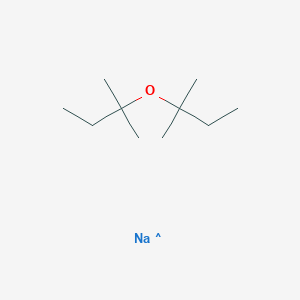
Sodium t-amyl oxide
- Klicken Sie auf QUICK INQUIRY, um ein Angebot von unserem Expertenteam zu erhalten.
- Mit qualitativ hochwertigen Produkten zu einem WETTBEWERBSFÄHIGEN Preis können Sie sich mehr auf Ihre Forschung konzentrieren.
Übersicht
Beschreibung
Sodium t-amyl oxide is a useful research compound. Its molecular formula is C10H22NaO and its molecular weight is 181.27 g/mol. The purity is usually 95%.
BenchChem offers high-quality this compound suitable for many research applications. Different packaging options are available to accommodate customers' requirements. Please inquire for more information about this compound including the price, delivery time, and more detailed information at [email protected].
Wissenschaftliche Forschungsanwendungen
Organic Synthesis
Sodium t-amyl oxide serves as a strong base in organic reactions, facilitating the deprotonation of weak acids. This property is essential for forming carbon-carbon bonds, which are crucial in synthesizing complex organic molecules. Its role in organic synthesis can be summarized as follows:
Polymer Chemistry
In polymer chemistry, this compound is utilized to synthesize polyolefins, which are essential for producing plastics and elastomers with enhanced properties. Its applications include:
| Application | Description |
|---|---|
| Polymerization | Facilitates the polymerization process to create high-performance materials. |
| Material Properties | Enhances the mechanical and thermal properties of polymers . |
Pharmaceutical Development
This compound plays a critical role in pharmaceutical development by acting as a reagent in the synthesis of drug intermediates. Its applications include:
Analytical Chemistry
In analytical chemistry, this compound enhances the sensitivity and selectivity of assays, making it valuable for quality control processes. Its contributions include:
| Application | Description |
|---|---|
| Assay Enhancement | Improves detection limits and specificity in chemical analyses. |
| Quality Control | Used in various assays to ensure compliance with regulatory standards . |
Environmental Applications
This compound has potential applications in environmental remediation, particularly in breaking down hazardous substances through chemical reactions. Its role includes:
| Application | Description |
|---|---|
| Contaminant Remediation | Utilized to degrade pollutants in contaminated sites through chemical reactions . |
Case Study 1: Organic Synthesis
A study demonstrated the use of this compound in synthesizing complex molecules such as alkaloids and terpenes through deprotonation reactions that facilitated carbon-carbon bond formation.
Case Study 2: Pharmaceutical Development
Research highlighted this compound's effectiveness in synthesizing pharmaceutical intermediates for anti-inflammatory drugs, showcasing its importance in drug discovery and development processes.
Case Study 3: Environmental Remediation
An investigation into the use of this compound for remediating soil contaminated with heavy metals showed promising results, indicating its potential for breaking down toxic substances effectively.
Eigenschaften
Molekularformel |
C10H22NaO |
|---|---|
Molekulargewicht |
181.27 g/mol |
InChI |
InChI=1S/C10H22O.Na/c1-7-9(3,4)11-10(5,6)8-2;/h7-8H2,1-6H3; |
InChI-Schlüssel |
UIIJZQVROQHLAP-UHFFFAOYSA-N |
Kanonische SMILES |
CCC(C)(C)OC(C)(C)CC.[Na] |
Herkunft des Produkts |
United States |
Synthesis routes and methods I
Procedure details




Synthesis routes and methods II
Procedure details





Haftungsausschluss und Informationen zu In-Vitro-Forschungsprodukten
Bitte beachten Sie, dass alle Artikel und Produktinformationen, die auf BenchChem präsentiert werden, ausschließlich zu Informationszwecken bestimmt sind. Die auf BenchChem zum Kauf angebotenen Produkte sind speziell für In-vitro-Studien konzipiert, die außerhalb lebender Organismen durchgeführt werden. In-vitro-Studien, abgeleitet von dem lateinischen Begriff "in Glas", beinhalten Experimente, die in kontrollierten Laborumgebungen unter Verwendung von Zellen oder Geweben durchgeführt werden. Es ist wichtig zu beachten, dass diese Produkte nicht als Arzneimittel oder Medikamente eingestuft sind und keine Zulassung der FDA für die Vorbeugung, Behandlung oder Heilung von medizinischen Zuständen, Beschwerden oder Krankheiten erhalten haben. Wir müssen betonen, dass jede Form der körperlichen Einführung dieser Produkte in Menschen oder Tiere gesetzlich strikt untersagt ist. Es ist unerlässlich, sich an diese Richtlinien zu halten, um die Einhaltung rechtlicher und ethischer Standards in Forschung und Experiment zu gewährleisten.













